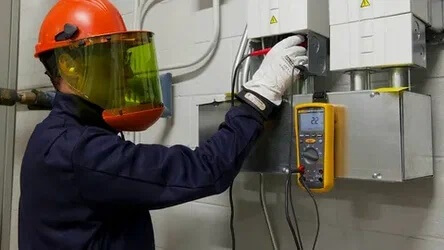In high-voltage electrical work, insulated personal protective equipment (PPE) is the lifeline for electricians. While many assume “insulation PPE = gloves,” comprehensive safety demands full-body protection. This guide decodes the complete system of electrical insulation gear, aligned with international standards and industry best practices, to help professionals select compliant and effective solutions.
1. Core Principles of Electrical Insulation Protection
Electricians face risks including direct electric shock, arc flashes, and electromagnetic radiation. Effective PPE must address:
- Full-body insulation: Protect all exposed body parts (hands, feet, torso) and surroundings (ground, tools).
- Dual protection: Base insulation (equipment) + supplementary barriers (e.g., insulating mats).
- Environmental adaptability: Resist high temperatures, humidity, and chemical corrosion.
2. Full-Body Insulation Gear Checklist
1. Head Protection: Insulated Safety Helmets
- Functions: Shock prevention, impact resistance (falling objects), arc flash protection.
- Standards:
- GB 2811 (China): Impact resistance ≤4,900N, puncture resistance ≤3,600N.
- EN 50365 (EU): Must withstand 10kV/3-minute insulation tests.
- Key features: Flame-retardant inner lining; fiberglass-reinforced resin shells for lightweight durability.
2. Hand Protection: Insulated Gloves
- Classifications & Applications:
Standard Class Voltage Rating Use Cases GB/T 17622 Class C ≤10,000V High-voltage repairs EN 60903 Class 4 ≤36,000V Ultra-high-voltage grids ASTM D120 Type III ≤26,500V Industrial power systems - Innovations: Double-layer design (abrasion-resistant rubber + cotton lining); anti-slip palm patterns.
3. Torso Protection: Insulated Clothing
- Design:
- Outer layer: PVC-coated nylon (chemical/arc resistance).
- Mid-layer: Electrostatic shielding fabric (current dispersion).
- Inner layer: Breathable nylon (moisture-wicking).
- Performance:
- Dielectric strength ≥7,000V (Q/321203CXA028-2013).
- Tear resistance ≥120N (weft direction).
4. Foot Protection: Insulated Boots
- Technology:
- Sole: Metal-free, triple-layer rubber (anti-slip + insulation).
- Upper: Leather ≥1.5mm thick; tear resistance ≥60N.
- Certifications:
- GB 12011 (China): 6kV AC withstand test (leakage current ≤1.8mA).
- EN 50321 (EU): 20kV boots for extreme humidity.
5. Auxiliary Insulation Gear
- Insulating Mats/Blankets: Voltage ratings from 5kV (standard) to 40kV (ultra-high voltage).
- Insulated Tools:
- Hot Sticks: Epoxy resin, 1-5m lengths (adaptable to voltage levels).
- Voltage Testers: Audible/visual alarms (0.4kV–500kV detection).
3. Buying Guide & Common Pitfalls
1. 4 Key Selection Criteria
- Voltage Matching: E.g., 10kV tasks require Class 2 (EN) or Class C (GB) gloves.
- Certification Checks: CQC mark for China; CE for EU exports.
- Top Brands:
Category Budget Brands Premium Brands Gloves Deltaplus, Blueshield Honeywell, 3M Boots Wealshield, Jintu Qiangren, Langmeng Insulated Suits Ansell DuPont, Lakeland
2. Avoid These Mistakes
- Myth 1: “Insulated boots replace safety boots” → Insulated boots lack anti-impact features (add steel toes per GB 21148).
- Myth 2: “High-voltage gloves are reusable” → EN mandates post-use electrical retesting for Class 3/4 gloves.
4. Future Trends: Smart Insulation PPE
- Real-Time Monitoring: Sensors alerting to insulation failure or leakage.
- Lightweight Materials: Carbon nanotube coatings reduce suit weight by 40%.
- Adaptive Design: Temperature-regulating liners (-20°C to +50°C).








